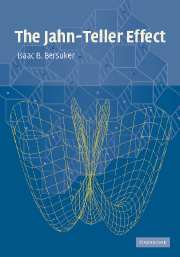Book contents
- Frontmatter
- Contents
- Preface
- Abbreviations
- 1 Introduction
- 2 Vibronic interactions
- 3 Formulation of Jahn–Teller problems. Adiabatic potentials
- 4 Pseudo Jahn–Teller, product Jahn–Teller, and Renner–Teller effects
- 5 Solutions of vibronic equations. Energy spectra and JT dynamics
- 6 The JTE in spectroscopy: general theory
- 7 Geometry, spectra, and reactivity of molecular systems
- 8 Solid-state problems: local properties and cooperative phenomena
- Appendix
- Subject index
- Formula index
6 - The JTE in spectroscopy: general theory
Published online by Cambridge University Press: 07 December 2009
- Frontmatter
- Contents
- Preface
- Abbreviations
- 1 Introduction
- 2 Vibronic interactions
- 3 Formulation of Jahn–Teller problems. Adiabatic potentials
- 4 Pseudo Jahn–Teller, product Jahn–Teller, and Renner–Teller effects
- 5 Solutions of vibronic equations. Energy spectra and JT dynamics
- 6 The JTE in spectroscopy: general theory
- 7 Geometry, spectra, and reactivity of molecular systems
- 8 Solid-state problems: local properties and cooperative phenomena
- Appendix
- Subject index
- Formula index
Summary
With this chapter we begin the applications of the general theory of the JTE to all-range spectroscopy, molecular structure, and solid-state physics (Chapters 6–8). Among them the JTE in spectral properties is the most significant due to the sensitivity of spectra to changes in electronic structure and vibronic coupling. On the other hand, the influence of vibronic coupling on spectra is very specific; it depends on both the system parameters and the spectral range under consideration. Still there are some general features common to all systems with the same JT problem.
This chapter is devoted to such a general theory of the JTE in spectroscopy. More particular problems are considered in Chapters 7 and 8, together with the corresponding specific systems, but the separation of the general theory from more system-oriented questions is to a large extent conventional. Obviously, there is also substantial overlap with calculations of vibronic states presented in Chapter 5: spectroscopy is inalienable from energies and wavefunctions of the system.
Electronic transitions
Optical band shapes
Optical band shapes with the JTE were subjected to multiple investigations by many authors (see the reviews [6.1–6.10] and references therein).
The term band shape means an envelope of elementary transitions between vibronic states, each of which has a specific width so that the vibronic lines merge into a continuous band.
- Type
- Chapter
- Information
- The Jahn-Teller Effect , pp. 263 - 352Publisher: Cambridge University PressPrint publication year: 2006



